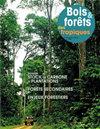基于景观方法评估森林退化的热带森林生态脆弱性评估框架:巴西和越南的案例研究
IF 0.6
4区 农林科学
Q3 FORESTRY
引用次数: 0
摘要
保护世界热带森林覆盖对于确保可持续的生态系统服务至关重要。然而,人口增长、对农产品需求增加和土地利用变化正在影响其可持续性。本文旨在开发一种多维方法来评估森林退化及其与土地利用动态的关系,以评估森林脆弱性。本文的研究在巴西的Paragominas和越南的Di Linh进行。在Paragominas,森林退化与选择性采伐和森林火灾直接相关,后者改变了森林结构。我们利用遥感工具和碳储量数据绘制了空中森林生物量图,并研究了退化对森林结构的影响。我们观察到,58%的森林退化是由土地利用的变化造成的。退化森林的分布是由大豆种植扩大造成的森林破碎造成的,但也与最近的毁林和刀耕火种做法有关。在迪林,森林退化是由于咖啡种植园的侵占。通过将不同类型的土地利用清单与Sentinel-2图像相结合,我们能够绘制出当前的土地覆盖情况。然后,我们建立了景观动态的轨迹,以表征农业边界的扩张。我们确定了对森林覆盖产生或大或小强度影响的退化和破碎化轨迹。综合来看,这些指标揭示了脆弱性热点。由于在景观尺度上为森林开发的遥感方法和指标,我们能够对人类改变的景观中的森林进行全面诊断。本文旨在为在景观尺度上对退化森林进行适当的优先管理开辟道路。本文章由计算机程序翻译,如有差异,请以英文原文为准。
Un cadre d'évaluation de la vulnérabilité écologique des forêts dans les fronts de déforestation tropicaux à partir de l'évaluation de la dégradation des forêts dans une approche paysagère : études de cas au Brésil et Vietnam
Conservation of the world's tropical forest cover is essential to ensure sustainable ecosystem services. However, population growth, increasing demand for agricultural products and land use changes are affecting their sustainability. This thesis aimed to develop a multi-dimensional approach to assess forest degradation and how it is related to land use dynamics, in order to estimate forest vulnerability. The studies for this thesis were conducted in Paragominas (Brazil) and Di Linh (Vietnam). In Paragominas, forest degradation is directly linked to selective logging and forest fires, which alter the structure of forests. We used remote sensing tools and data on carbon stocks to map aerial forest biomass, and investigated the consequences of degradation on forest structure. We observed that 58% of forest degradation was accounted for by changes in land use. The distribution of degraded forests is driven by their fragmentation due to the expansion of soya cultivation, but is also associated with recent deforestation and slash-and-burn practices. In Di Linh, forest degradation is due to encroachment by coffee plantations. By combining an inventory of different types of land use with Sentinel-2 images, we were able to map current land cover. We then built up the trajectories of landscape dynamics to characterise the expansion of the agricultural frontier. We identified the degradation and fragmentation trajectories that produce effects of greater or lesser intensity on the forest cover. Taken together, these indicators bring out vulnerability hotspots. Thanks to the remote sensing approaches and indicators developed for forests on the landscape scale, we were able to provide a holistic diagnosis of forests within landscapes altered by humans. This thesis aims to open up avenues for appropriate and priority management of degraded forests on the scale of the landscape.
求助全文
通过发布文献求助,成功后即可免费获取论文全文。
去求助
来源期刊

Bois et Forets Des Tropiques
FORESTRY-
CiteScore
1.50
自引率
16.70%
发文量
31
审稿时长
>12 weeks
期刊介绍:
In 1947, the former Tropical Forest Technical Centre (CTFT), now part of CIRAD, created the journal Bois et Forêts des Tropiques. Since then, it has disseminated knowledge and research results on forests in intertropical and Mediterranean regions to more than sixty countries. The articles, peer evaluated and reviewed, are short, synthetic and accessible to researchers, engineers, technicians, students and decision-makers. They present original, innovative research results, inventions or discoveries. The journal publishes in an international dimension. The topics covered are of general interest and are aimed at an informed international audience.
 求助内容:
求助内容: 应助结果提醒方式:
应助结果提醒方式:


